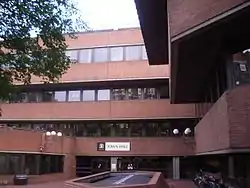Kensington and Chelsea London Borough Council
Kensington and Chelsea London Borough Council is the local authority for the Royal Borough of Kensington and Chelsea in Greater London, England. It is a London borough council, one of 32 in the United Kingdom capital of London. Kensington and Chelsea is divided into 18 wards, each electing either two or three councillors.[1] The council was created by the London Government Act 1963 and replaced two local authorities: Kensington Metropolitan Borough Council and Chelsea Metropolitan Borough Council. The borough council provides some shared services with Hammersmith and Fulham, and Westminster.
Kensington and Chelsea London Borough Council | |
|---|---|
 Coat of arms | |
 Council logo | |
| Type | |
| Type | |
| History | |
| Founded | 1 April 1965 |
| Preceded by | Chelsea Borough Council Kensington Borough Council |
| Leadership | |
Mayor of Kensington & Chelsea | Cllr Gerard Hargreaves since 20 May 2020 |
Leader of the Council | |
Chief executive | Barry Quirk since 22 August 2018 |
| Structure | |
| Seats | 50 councillors |
 | |
Political groups |
|
Length of term | Whole council elected every four years |
| Elections | |
| Plurality-at-large | |
Last election | 3 May 2018 |
Next election | 5 May 2022 |
| Meeting place | |
 | |
| Town Hall, Hornton Street | |
| Website | |
| www | |
History
There have previously been a number of local authorities responsible for the Kensington and Chelsea area. The current local authority was first elected in 1964, a year before formally coming into its powers and prior to the creation of the London Borough of Kensington and Chelsea on 1 April 1965. Kensington and Chelsea London Borough Council replaced Kensington Metropolitan Borough Council and Chelsea Metropolitan Borough Council. Both were created in 1900 and replaced the Vestry of the Parish of Kensington and the Vestry of the Parish of Chelsea.[2]
It was envisaged, in accordance with the London Government Act 1963, that Kensington and Chelsea as a London local authority would share power with the Greater London Council. The split of powers and functions meant that the Greater London Council was responsible for "wide area" services such as fire, ambulance, flood prevention, and refuse disposal; with the local authorities responsible for "personal" services such as social care, libraries, cemeteries and refuse collection. This arrangement lasted until 1986 when Kensington and Chelsea London Borough Council gained responsibility for some services that had been provided by the Greater London Council, such as waste disposal. Kensington and Chelsea became an education authority in 1990. Since 2000 the Greater London Authority has taken some responsibility for highways and planning control from the council, but within the English local government system the council remains a "most purpose" authority in terms of the available range of powers and functions.[3]
Powers and functions
The local authority derives its powers and functions from the London Government Act 1963 and subsequent legislation. Kensington and Chelseahas the powers and functions of a London borough council. It is a billing authority collecting Council Tax and business rates, it processes local planning applications, and it is responsible for housing, waste collection and environmental health. It is a local education authority, responsible for social services, libraries and waste disposal. The council shares responsibility with the Greater London Authority for strategic policies including housing, planning and the environment.[4]
Finances
Kensington and Chelsea London Borough Council is the billing authority for Council Tax, and collects precepts on behalf of the Mayor's Office for Policing and Crime, the London Fire and Emergency Planning Authority, the Greater London Authority and Transport for London.[5]
Summary results of elections
The council has been controlled by the Conservative Party since it was first elected in 1964.
After new boundaries were set by the Boundary Commission, the Conservatives lost the Earl's Court Ward by-election in September 2010 to the Liberal Democrats and narrowly won the Cremorne Ward by-election by only 19 votes.[6] Many commentators blamed the Conservative councillors led by Merrick Cockell for these poor results, stating that the Council did not adequately take into account residents' views on projects such as the proposed Thames Tideway Tunnel and the Earl's Court building works.[7][8]
As of May 2018, the council composition is: Conservative 36 (-1), Labour 13 (+2) and Lib Dem 1 (-1).[9]
Grenfell Tower fire
On 14 June 2017 a major fire destroyed the council-owned, 24-storey Grenfell Tower, providing public housing in the mainly working-class area of North Kensington, causing 72 deaths.[10] The tower block was managed on behalf of (but independently of) the council by Kensington and Chelsea Tenant Management Organisation (KCTMO), the largest tenant management organisation (TMO) in England, which is responsible for the management of nearly 10,000 properties in the borough.[11]
On 18 June, the government relieved Kensington and Chelsea London Borough Council of responsibility for supporting the survivors, after a perceived inadequate response. Responsibility was handed over to a Grenfell fire-response team led by a group of chief executives from councils across London. Resources available to them included central government, the British Red Cross, the Metropolitan Police, the London Fire Brigade and local government across London. Neighbouring councils sent in staff to improve the rehousing response.[12][13]
On 21 June, the Council chief executive Nicholas Holgate resigned amid criticism over the borough's response to the fire.[14] The Prime Minister Theresa May commented that the council "couldn't cope" in the response to the fire, and that it "was right" that the chief executive had resigned.[15] The Conservative leader of the council, Nicholas Paget-Brown resisted calls to resign,[12] but he announced on 30 June that he would step down[16] and was replaced as leader by Conservative Elizabeth Campbell on 19 July 2017.[17] Lewisham Council CEO Barry Quirk was seconded to take over from Nicholas Holgate in June and took up the Chief Executive role on a permanent basis in September 2017.[18]
References
- "Our councillors". Rbkc.gov.uk. 17 September 2009. Retrieved 22 May 2012.
- Youngs, Frederic (1979). Guide to the Local Administrative Units of England. I: Southern England. London: Royal Historical Society. ISBN 0-901050-67-9.
- Leach, Steve (1998). Local Government Reorganisation: The Review and its Aftermath. Routledge. p. 107. ISBN 978-0714648590.
- "Local Plan Responses – within and outside London". Mayor of London. Retrieved 9 April 2020.
- "Council Tax and Business Rates Billing Authorities". Council Tax Rates. Retrieved 8 April 2020.
- "Cremorne Ward By-election Sep 2010". Rbkc.gov.uk. 17 September 2009. Retrieved 22 May 2012.
- "Council byelection results from yesterday | Local Government". Conservativehome.blogs.com. 17 September 2010. Retrieved 22 May 2012.
- Hodges, Dan. "By-election results in". Kensington & Chelsea Chronicle. Retrieved 22 May 2012.
- "Election Results May 2018". Kensington and Chelsea London Borough Council. Retrieved 26 April 2020.
- Grenfell Tower: Inquiry opens with tribute to stillborn baby. BBC.
- "Kensington and Chelsea Tenant Management Organisation – The Board". kctmo.org.uk. Archived from the original on 17 June 2017. Retrieved 14 June 2017.
- Macaskill, Ewen (18 June 2017). "Council sidelined in Grenfell Tower response as leader refuses to quit". The Observer. Retrieved 19 June 2017.
- Cornish, Chloe; Jack, Andrew (18 June 2017). "Kensington council sidelined after faltering Grenfell relief effort". Financial Times. Retrieved 19 June 2017.
- "London fire: Kensington council boss quits over Grenfell tragedy". BBC News. 22 June 2017. Retrieved 22 June 2017.
- "High rise cladding 'combustible' says PM". BBC News. 22 June 2017. Retrieved 22 June 2017.
- Walker, Peter (30 June 2017). "Kensington and Chelsea council leader quits in wake of Grenfell disaster". The Guardian. Retrieved 30 June 2017.
- "Grenfell Tower fire: New council leader heckled by public". BBC News. 19 July 2017. Retrieved 19 July 2017.
- Anthony Barej (11 September 2017) "Lewisham chief to join RBKC permanently following Grenfell", Public Finance magazine. Chartered Institute of Public Finance and Accountancy. Retrieved 24 June 2018.